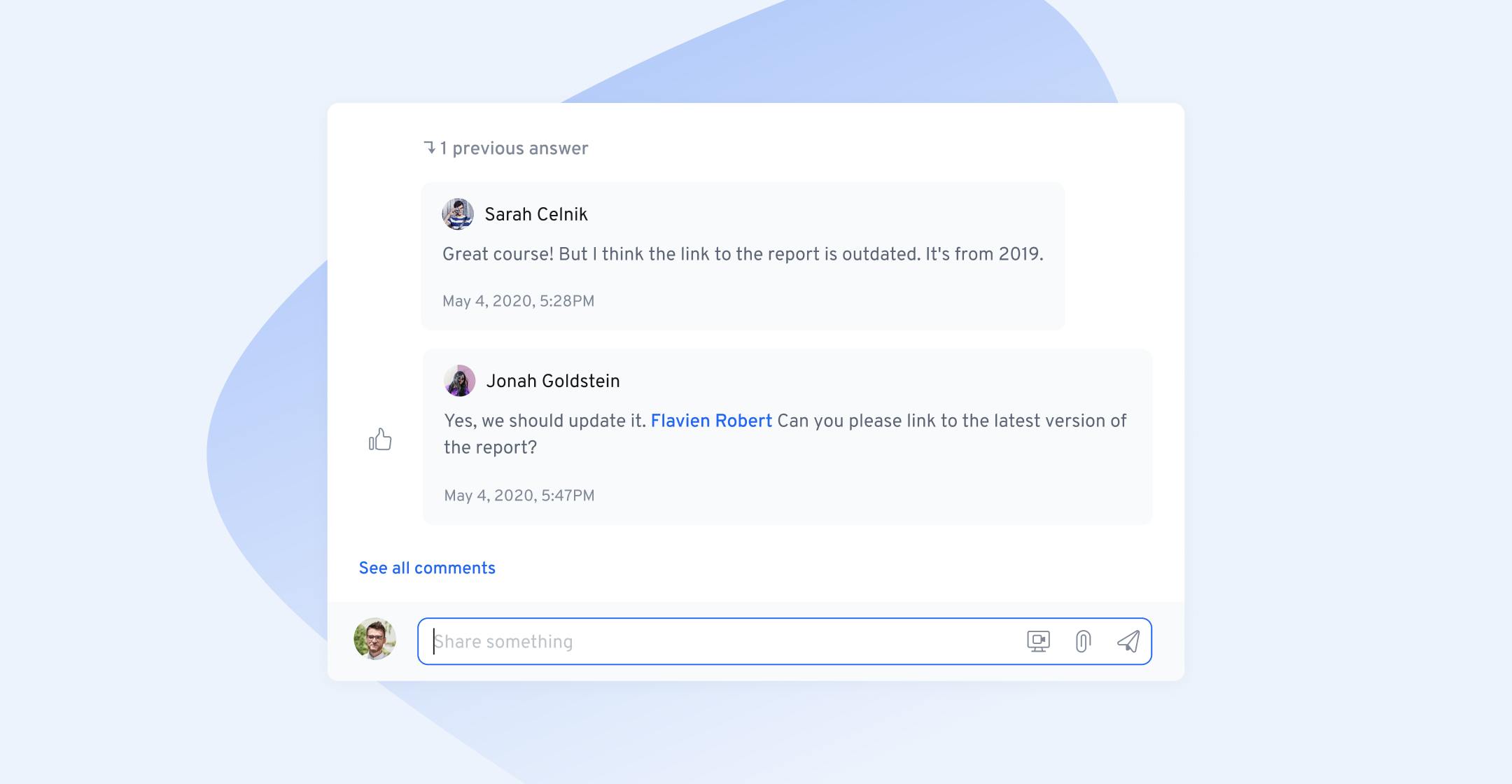Three-quarters of workers report feeling burned out at work, according to a recent FlexJobs and Mental Health America study. The sad truth is that employees don’t have the time or energy to get excited about learning—which leads to dismal engagement and course completion rates.
The biggest problem is that most Learning and Development professionals base their training programs on passive learning. Tedious and isolating, passive eLearning programs lack the human-to-human component essential to effective learning.
But it doesn’t have to be this way.
The flip side of passive learning—active learning—puts personal interaction at the heart of the training process. Even better, recent scientific research has proven that this active approach is more effective at creating lasting learning outcomes.
For your eLearning program to succeed, you need to understand what active learning is, why it’s more effective from a scientific perspective, and how you can apply it through Collaborative Learning.
What is ‘active’ and ‘passive’ learning?
Active learning is a process where learners are involved in constructing their own understanding of a subject, often through group interactions and applied thinking. When your high school teacher asked you to break into groups to solve a math problem or your driving instructor made you explain a safety concept to the class, they were using active learning principles.
Passive learning, on the other hand, involves learners that passively take in material from an instructor, with little to no participation. Lecture halls filled with university students taking notes from a lone professor droning into a microphone is a good example.
Though passive learning is all too common, it just isn’t as effective as active learning, as researchers are discovering.
Science backs active learning
Research shows that people learn better with active learning. One great example is work conducted at the University of Washington. Researchers ran a meta-analysis of 225 studies examining STEM (science, technology, engineering, and mathematics) student achievement rates. They were looking to see if students performed better if they were part of an active versus passive learning environment.
The results were clear: Not only did active learning lead to increases in examination performance that would raise average grades by half a letter, but students taught by traditional lecture-based learning were 1.5 times more likely to fail than those taught using active learning. Not only does active learning boost performance, but passive learning can harm it.
Revolutionary work by Education Researcher Sugatra Mitra proves this point even further. He demonstrated that children from rural villages were able not only to teach themselves how to use a computer in a foreign language, but also the basics of biotechnology concepts.
They managed these remarkable achievements through pure active learning. Mitra’s experiments consisted of leaving the kids together to work independently of any adults. He discovered that through group interaction—with some students even taking on the role of instructor—the children could learn much more than anyone expected.
So, what conclusion can we draw? People learn better when they interact with each other.
Let’s dig even deeper into the scientific basis behind why this human-to-human interaction leads to better learning outcomes—and more importantly, how to include them in your L&D program.
Related: Decentralized Learning in Practice: How Visa Leverages User-Generated Content
1. Include interactive components in your learning courses to stimulate mirror neurons
One of the reasons active learning is more effective is because, at the neurological level, humans learn through observation, understanding, and imitating. Scientists came to this conclusion thanks to Giacomo Rizzolatti’s discovery of ‘mirror neurons’ in the 1990s.
Rizzolatti was an Italian neurophysiologist studying the neurons that control motor movements in macaque monkeys. During his experiments, he made the surprising discovery that the same neurons that fire in macaque monkeys when they perform an action themselves also fire when they observe another monkey performing that same action. Rizzolatti had discovered mirror neurons.
This finding strengthened the scientific understanding of learning as an active process. Animals and people alike learn through interpersonal observation and imitation.
For Learning and Development teams, this means you can’t rely on traditional, dry SCORM-based content. A typical eLearning module that asks learners to sit and pore over material in solitary silence isn’t going to cut it.
Instead, try building peer feedback, interactive quizzes, or discussion forums into your courses. This will encourage learner interaction and stimulate those mirror neurons so essential to learning.

On a more macro level, additional research by Antonio Battro demonstrates that questions and answers are an integral part of the active learning process—and one that L&D teams should exploit.
Related: How We Use Peer Learning to Keep Our Company’s Competitive Edge
2. Encourage interactive dialogue between learners and subject-matter experts to boost engagement
Battro’s study, ‘The Cognitive Neuroscience of the Teacher-Student Interaction,’ found that in a learning setting, the engagement—measured by brain activity—of instructor and learner were linked.
Battro broke students into pairs and had them read dialogue where one student played the role of instructor, and the other, student. Measuring brain activity with near-infrared spectroscopy, they found that whenever an expert had high brain activity during the discussion, the learner also showed heightened activity. And the opposite was true: for learners who had lower levels of brain activity, the expert in these duos did, also.
What he concluded was that asking questions of learners generates higher brain activity. And interestingly, when experts are more engaged in the conversation or exchange, so is the learner.
L&D teams can use these findings as rationales to build more open conversation, dialogue, and collaboration into their courses. Instead of just setting a curriculum of course content and tracking completions, experts will use active discussion to increase learner motivation, retention, and feedback.

Take a closer look at the science behind active learning
Learning and Development teams can’t afford to rely on passive, ineffective training programs to inspire learners. This was true before the COVID-19 pandemic, and it’s only become more relevant now that employee disengagement is on the rise.
In this post, we’ve explored a few ideas on how to incorporate active learning into your L&D programs and strategies. For a more comprehensive look at the science explaining why active learning achieves better outcomes, check out the full ebook, below.



